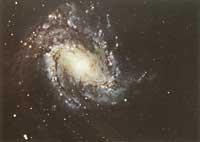The Star Nest of Orio
1990/03/01 Elhuyar Zientzia Iturria: Elhuyar aldizkaria
Using one of the latest advances in astronomical instrumentation, astronomers have entered the dust cloud of the Orio nebula and taken photographs of the star nest.
The photographs were obtained using an infrared electronic camera. The camera is similar to that used by optical astronomers, but instead of having an emulsion to detect visible light, it has near-infrared radiation detectors (infrared light near the visible wavelength). Since interstellar dust is transparent to infrared radiation, its study allows to detect the liver contents of dust clouds.
Until about three years ago, infrared detectors were not sufficiently sensitive to differentiate isolated sources.
In December 1987, at NASA's Mark MacCaugh and astronomers Colin Aspin of the Hilo Astronomical Center (Hawaii) connected the 26 x 58 pixel infrared camera to the 3.8-m Mauna Ke infrared telescope.
Using three different filters, 145 images were taken, 435 in total. Combining these images with the computer they obtained a color image.
The image shows a fortnight of small mass stars (of which a fifth is also seen optically) centered on Trapeciium. The trapecium consists of four massive blue stars responsible for the ionization of the nebula. Most of the participants in this stellar cluster are very young from the astronomical point of view. Only one million years ago.
The new cameras have accelerated infrared astronomy by a thousand. Projects that were to be developed for years using old tools are carried out in a few nights, since with the new cameras astronomers can obtain high-resolution infrared images of large celestial fragments. They show us in depth the infrared universe, as the Galileo telescope has taught us the optical universe.

Gai honi buruzko eduki gehiago
Elhuyarrek garatutako teknologia




